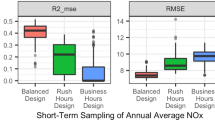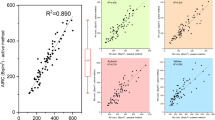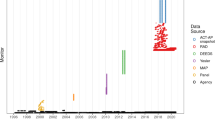Abstract
Background
Knowing the geographical and temporal variation in radon concentrations is essential for assessing residential exposure to radon, the leading cause of lung cancer in never-smokers in the United States. Tens of millions of short-term radon measurements, which normally last 2 to 4 days, have been conducted during the past decades. However, these massive short-term measurements have not been commonly used in exposure assessment because of the conflicting evidence regarding their correlation with long-term measurements, the gold standard of assessing long-term radon exposure.
Objective
We aim to evaluate the extent to which a long-term radon measurement can be predicted by a collocated short-term radon measurement under different conditions.
Methods
We compiled a national dataset of 2245 pairs of collocated short- and long-term measurements, analyzed the predictability of long-term measurements with stratified linear regression and bootstrapping resampling.
Results
We found that the extent to which a long-term measurement can be predicted by the collocated short-term measurement was a joint function of two factors: the temporal difference in starting dates between two measurements and the length of the long-term measurement. Short-term measurements, jointly with other factors, could explain up to 79% (0.95 Confidence Interval [CI]: 0.73–0.84) of the variance in seasonal radon concentrations and could explain up to 67% (0.95 CI: 0.52–0.81) of the variance in annual radon concentrations. The large proportions of variance explained suggest that short-term measurement can be used as convenient proxy for seasonal radon concentrations. Accurate annual radon estimation entails averaging multiple short-term measurements in different seasons.
Significance
Our findings will facilitate the usage of abundant short-term radon measurements, which have been obtained but was previously underutilized in assessing residential radon exposure.
Impact statement
-
Tens of millions of short-term radon measurements have been conducted but underutilized in assessing residential exposure to radon, the greatest cause of lung cancer in non-smokers. We investigate the correlations between collocated short- and long-term measurements in 2245 U.S. buildings and find that short-term measurements can explain ~75% of the variance in subsequent long-term measurements in the same buildings. Our results can facilitate the usage of massive short-term radon measurements that have been conducted to estimate the spatial and longitudinal distribution of radon concentrations, which can be used in epidemiological studies to quantify the health effects of radon.
This is a preview of subscription content, access via your institution
Access options
Subscribe to this journal
Receive 6 print issues and online access
$259.00 per year
only $43.17 per issue
Buy this article
- Purchase on Springer Link
- Instant access to full article PDF
Prices may be subject to local taxes which are calculated during checkout





Similar content being viewed by others
Code availability
All model codes are available at the following link: https://github.com/longxiang1025/Radon_Mortality.
Data availability
The final research data will be stored in a public respiratory upon publication.
References
Otton JK. The geology of radon. Washington, D.C: United States Geological Survey; 1992.
National Council on Rediation Protection and Measurements (NCRP Health risks from exposure to low levels of ionizing radiation: BEIR VII phase 2. . Washington D.C: The National Academies Press; 2006. https://books.google.com/books?hl=en&lr=&id=H4J3Ns_3lUIC&oi=fnd&pg=PR1&dq=Heal347th+Risks+from+Exposure+to+Low+Levels+of+4205+Ionizing+Radiation:+BEIR+VII+Phase+2.348&ots=mFFZ-xt4IV&sig=CWfM5-bCyZ1wUA3Yt4KVbih8Qkc Accessed 27 Jul 2019.
Nero AV, Schwehr MB, Nazaroff WW, Revzan KL. Distribution of airborne radon-222 concentrations in U.S. homes. Science (1979). 1986;234:992–7.
Marcinowski F, Lucas RM, Yeager WM. National and regional distributions of airborne radon concentrations in U.S. homes. Health Phys. 1994;66:699–706. https://journals.lww.com/health-physics/Fulltext/1994/06000/National_and_Regional_Distributions_of_Airborne.9.aspx.
15 United States Constitution § 2661-2671. Indoor Radon Abatement Act. United States: Unites States House of Representatives; 1988. https://uscode.house.gov/view.xhtml?path=/prelim@title15/chapter53/subchapter3 accessed 25 Apr 2022.
United States. Environmental Protection Agency, Centers for Disease Control (US). A citizen’s guide to radon: the guide to protecting yourself and your family from radon. 2016.
Gregory B, Jalbert PP. National radon results: 1985 to 2003. Washington, DC: US Environmental Protection Agency; 2004. p. 1–7.
George AC. The history, development and the present status of the radon measurement programme in the United States of America. Radiat Prot Dosim. 2015;167:8–14.
Li L, Blomberg AJ, Stern RA, Kang C-M, Papatheodorou S, Wei Y, et al. Predicting monthly community-level domestic radon concentrations in greater boston area with an ensemble learning model. Environ Sci Technol. 2021;55:7157–66.
Price PN. Predictions and maps of county mean indoor radon concentrations in the Mid-Atlantic states. Health Phys. 1997;72:893–906.
Price P, Nero A Mapping of mean radon concentrations, using survey data and covariates. In: Proc. international radon symposium. Lawrence Berkeley National Laboratory. 1996.
Elizabeth Ann Glass Geltman. State Radon Laws. 2016. https://lawatlas.org/datasets/state-radon-laws. Accessed 28 Nov 2021.
United States Environmental Protection Agency. Protocols for radon and radon decay product measurements in homes. 1993 https://archive.epa.gov/epa/sites/production/files/2014-08/documents/homes_protocols.pdf. Accessed 28 Nov 2021.
Venoso G, Iacoponi A, Pratesi G, Guazzini M, Boccini L, Corbani E, et al. Impact of temporal variability of radon concentration in workplaces on the actual radon exposure during working hours. Sci Rep. 2021;11:16984.
Miles J. Temporal variation of radon levels in houses and implications for radon measurement strategies. Radiat Prot Dosim. 2001;93:369–75.
Sun K, Majdan M, Field D, Field RW. Field comparison of commercially available short-term radon detectors. Health Phys. 2006;91:221–6.
Sun K, Budd G, McLemore S, Field RW. Blind testing of commercially available short-term radon detectors. Health Phys. 2008;94:548–57.
Price PN, Nero AV. Joint analysis of long- and short-term radon monitoring data from the northern U.S. Environ Int. 1996;22:699–714.
Li L, Stern RA, Blomberg AJ, Kang C-M, Wei Y, Liu M, et al. Ratios between radon concentrations in upstairs and basements: a study in the northeastern and midwestern United States. Environ Sci Technol Lett. 2022;9:191–7.
Groves-Kirkby CJ, Denman AR, Crockett RGM, Phillips PS, Woolridge AC, Gillmore GK. Time-integrating radon gas measurements in domestic premises: comparison of short-, medium- and long-term exposures. J Environ Radioactivity. 2006;86:92–109.
Hubbard LM, Mellander H, Swedjemark GA. Studies on temporal variations of radon in Swedish single-family houses. Environ Int. 1996;22:715–22.
Stanley FKT, Irvine JL, Jacques WR, Salgia SR, Innes DG, Winquist BD, et al. Radon exposure is rising steadily within the modern North American residential environment, and is increasingly uniform across seasons. Sci Rep. 2019;9:18472.
Ruano-Ravina A, Castro-Bernárdez M, Sande-Meijide M, Vargas A, Barros-Dios JM. Short- versus long-term radon detectors: a comparative study in Galicia, NW Spain. J Environ Radioactivity. 2008;99:1121–6.
Barros N, Steck DJ, Field RW. Utility of short-term basement screening radon measurements to predict year-long residential radon concentrations on upper floors. Radiat Prot Dosim. 2016;171:405–13.
Barros N, Steck DJ, Field RW. A comparison of winter short-term and annual average radon measurements in basements of a radon-prone region and evaluation of further radon testing indicators. Health Phys. 2014;106:535–44.
National Radon Proficiency Program. Manufacturer Device Performance Test (DPT) Requirements. 2021. https://nrpp.info/manufacturer-device-performance-test-dpt-requirements/. Accessed 11 Dec 2021.
National Radon Safety Board. Device Evaluation Request. 2018. https://www.nrsb.org/wp-content/uploads/2018/11/DeviceEvaluationApp082418.pdf. Accessed 11 Dec 2021.
EPA’s Map of Radon Zones: National Summary. 1993.
Luoma M, Batterman SA. Autocorrelation and variability of indoor air quality measurements. Am Ind Hyg Assoc. 2000;61:658–68.
Arvela H, Holmgren O, Hänninen P. Effect of soil moisture on seasonal variation in indoor radon concentration: modelling and measurements in 326 Finnish houses. Radiat Prot Dosim. 2016;168:277–90.
Akbari K, Mahmoudi J, Ghanbari M. Influence of indoor air conditions on radon concentration in a detached house. J Environ Radioactivity. 2013;116:166–73.
Acknowledgements
Shawn Price, Director of Laboratory Operations at Spruce Environmental Technologies, Inc, provided us with the radon measurements used in this study and reviewed the manuscript. This publication is made possible by U.S. EPA grant RD-835872, NIH grant R21ES029637, and NIH grant K99ES034459. Its contents are solely the responsibility of the grantee and do not necessarily represent the official view of the U.S. EPA or NIH. Further, U.S. EPA and NIH do not endorse the purchase of any commercial products or services mentioned in the publication.
Author information
Authors and Affiliations
Contributions
LL: Conceptualization, methodology, software, validation, formal analysis, investigation, writing—original draft, visualization. BAC: Methodology, writing—review & editing. PK: Conceptualization, resources, data curation, writing - review & editing, supervision, project administration, funding acquisition.
Corresponding author
Ethics declarations
Competing interests
The authors declare no competing interests.
Additional information
Publisher’s note Springer Nature remains neutral with regard to jurisdictional claims in published maps and institutional affiliations.
Supplementary information
Rights and permissions
Springer Nature or its licensor (e.g. a society or other partner) holds exclusive rights to this article under a publishing agreement with the author(s) or other rightsholder(s); author self-archiving of the accepted manuscript version of this article is solely governed by the terms of such publishing agreement and applicable law.
About this article
Cite this article
Li, L., Coull, B.A. & Koutrakis, P. A national comparison between the collocated short- and long-term radon measurements in the United States. J Expo Sci Environ Epidemiol 33, 455–464 (2023). https://doi.org/10.1038/s41370-023-00521-5
Received:
Revised:
Accepted:
Published:
Issue Date:
DOI: https://doi.org/10.1038/s41370-023-00521-5



